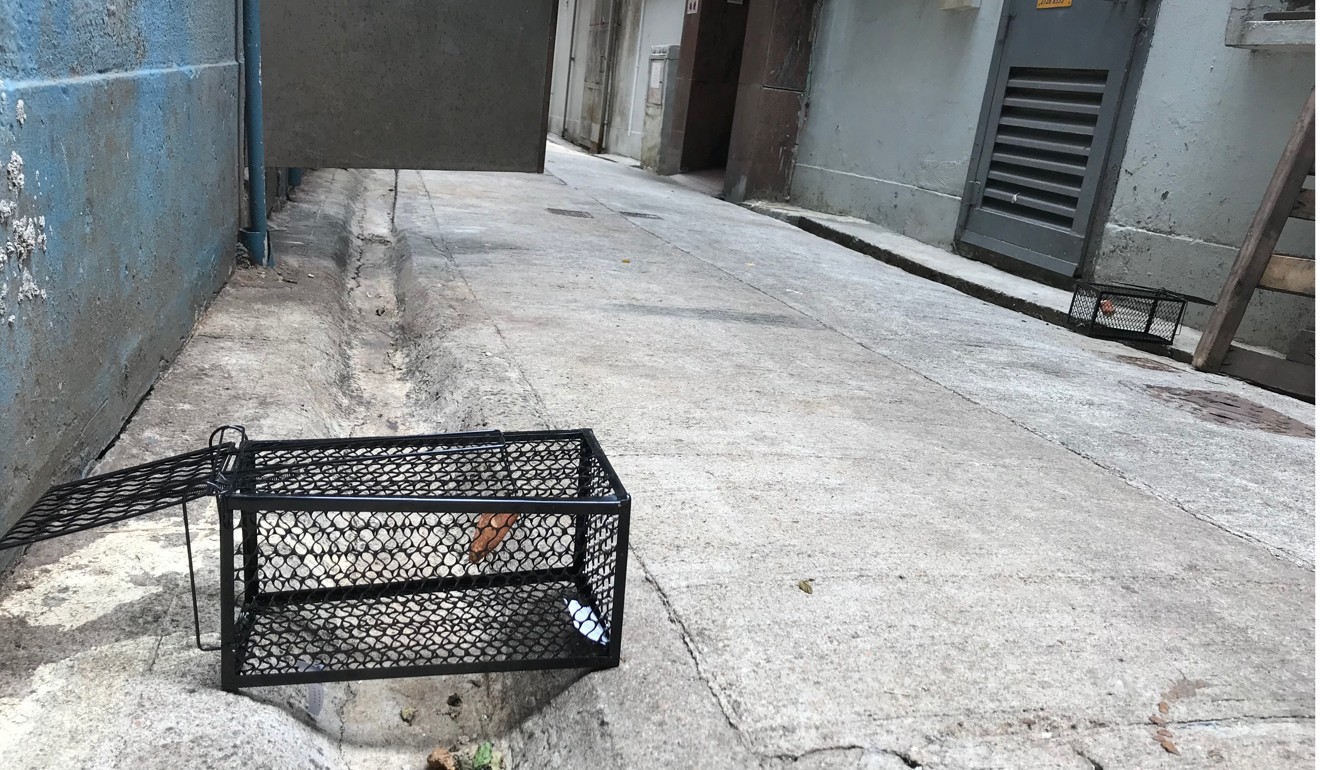
Sweet potatoes for bait and one-door cages – why Hong Kong’s old-style pest control methods are under fire after latest cases of rat hepatitis E infection in humans
- Team of more than 20 cleaners start disinfecting Tuen Mun estate where one patient had lived
- Outdated trapping methods and lack of support for private housing estates among complaints
Other complaints included a lack of support for private housing estates to tackle rats.
Officials stepped up cleaning efforts on Wednesday morning at the public housing Yau Oi Estate in Tuen Mun – where a 74-year-old man infected with the virus, and who later died in hospital, had lived.
A team of more than 20 cleaners started disinfecting and hosing down the estate from 7am. District councillors and Food and Environmental Hygiene Department (FEHD) officers also patrolled rodent “black spots” in the area, including Tuen Mun Park and the sides of the Tuen Mun River.
But there was no action at the private residential areas where the other two reported cases – two men, aged 81 and 67 – lived, at South Horizons in Aberdeen and in Kowloon City.

Southern district councillor Judy Chan Ka-pui urged the government to extend cleaning services to private estates as well, as residents at South Horizons had to pay for pest control services themselves.
“Do not distinguish us as a private space. This ultimately affects all Hong Kong residents’ health,” Chan said, adding the estate’s property management company may not have expertise in rat control.
The FEHD said it would only carry out disinfection at private housing estates upon request. But Chan said that even then the department would only send staff if there was proof that disease could spread, such as the discovery of dead rats, and no cleaning was provided after workers retrieved the carcasses.
Hong Kong reported the world’s first case of a human infected with the rat hepatitis E virus in Wong Tai Sin last September, bringing the total to five as of May including the latest incidents.
Health experts said the latest incidents showed cases occurred from time to time in different parts of the city and were not one-off transmission. The source and route of the infections were under investigation.
Hong Kong man is world’s first human found with rat hepatitis E virus
The department said the rodent infestation rate was largely stable and under control, standing at 3.4 per cent last year. Officials said control methods had been effective, with 44,378 rats trapped and poisoned last year, up from 41,038 in 2017 and 37,169 in 2016.
However, rat catcher Gary Yam Wing-keung, a 30-year veteran, said that using cage traps and sweet potatoes as bait was ineffective.
“Rats won’t go into those traps because they see there is no way out,” Yam said. “Also, they are not attracted to the smell of sweet potatoes after a day or two. They’d rather forage for food waste from restaurants nearby.”
At Ma Hang Chung Road in Kowloon City, where one patient lived, sweet potatoes in two cages and a packet of rat poison hanging from a drainpipe were left untouched on Wednesday morning.
Retiree Amy Ho said rat infestation was rampant on that street while the block she lived in shared an alleyway with the back entrance of several restaurants.
“Sometimes scraps of leftover food fall out of the bins or some rude people just throw their trash in the alley. That’s why the rats all come out to party here at night,” Ho said.

Yam said most pest control firms used newer trap boxes laid with poisonous bait with two open ends, as opposed to cages, which only had one entrance. Boxes had a much higher success rate, at 70 per cent, he said.
Yam also said new technology the government was testing, such as night vision cameras, only took care of surveillance, while trapping devices driven by pressurised gas were also not effective.
He said officials had to solve the root of the problem – stopping restaurants from throwing out garbage in back alleys. “They can clean all they want, but if they don’t prosecute these restaurants, the rats are just going to keep coming back,” he said.

Steve Cho Wui-hung, vice-chairman of Kowloon City District Council, complained that officials were reluctant to admit there was a problem, although the numbers showed a different picture.
He said he received at least 500 complaints about mice infestations at Oi Man Estate in Ho Man Tin within two months.
One complainant said rats had climbed up a wall to a 20th-floor flat.
Cho’s colleague Jacky Lee Chiu-yu, also of the Business and Professionals Alliance, believed that recent construction in the area, such as a new MTR link, had caused the mice to move from their habitats.
Separately, the Ombudsman announced two investigations to monitor outsourced street cleansing services and the government’s management of public toilets.




